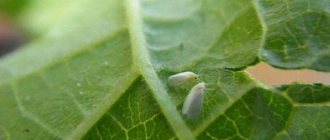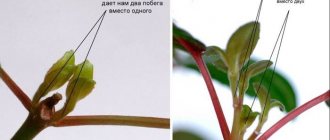- What is a spider mite and how does it reproduce? Life cycle of a spider mite.
- How are spider mites harmful to the plant?
- How can you tell if a plant is infected with spider mites? Symptoms of spider mites.
- How to treat a plant for spider mites? Means to combat spider mites.
- Fighting spider mites in the apartment.
- Folk remedies in the fight against spider mites. My processing scheme.
- Pros and cons of my scheme.
Now has come that time of year when even a tick can easily be “inflated” into an apartment by the wind from an open window.
Those who have trees near their windows/balconies are especially susceptible to this. Also, ticks can be “airborne” from neighbors above, because they are so light that they are carried by the wind like specks of dust. They can be brought in with a newly purchased plant, if it is not first quarantined. The biggest problem is fighting the tick, so, of course, it is better to prevent this matter.
I haven’t had any problems with mites for several years, since we moved to a new apartment, but this year I discovered a cobweb on the rose, and upon a detailed examination of the plants next to it, I also noticed disgusting living creatures.
What is a spider mite and how does it reproduce? Life cycle of a spider mite.
Spider mites are small insects whose size does not exceed 0.5 mm. It is very difficult to notice on a plant because with a small number of individuals, they rarely give themselves away, since they are very small and sit on the opposite side of the leaf. And even if we notice some dark grains, we most likely attribute it to careless watering and grains of soil getting onto the leaf. As a rule, the characteristic appearance of cobwebs means only one thing - there are too many ticks and they need to be dealt with immediately.
The tick reproduces very quickly: under favorable conditions, the female lays up to 250-300 eggs in 2-3 weeks, after which she dies. Favorable conditions for the development of spider mites are dryness and high temperature. The development cycle of a spider mite includes the following stages: egg, larva, protonymph, deuteronymph (in females), and adult. As a rule, from the very first stage (egg) to the adult individual it takes from 10 to 20 days, all other things being equal. So how does a mite harm a plant?
How to detect
This variation has a color suitable for camouflage and is small in size. They blend in with the foliage, which helps them stay in the shadows for a long time and go unnoticed.
It is much easier to detect its presence by the symptoms of the foliage. If there are few of them on the bush, then the leaves are simply covered with white spots, but if there is a large arch, the plant is enveloped in an almost imperceptible web, hence the name mite.
You can verify this by looking at photos of the flowers on which it started. The females of these creatures die about a month after birth, but during this time, unfortunately, they can lay over a hundred eggs.
How are spider mites harmful to the plant?
The spider mite is a living creature; it tends not only to reproduce, but also to feed. What does a spider mite eat? Everything is very simple, it feeds on the sap of the plant, piercing the leaf with its proboscis and releasing enzymes into it that destroy the chloroplasts of the cells.
As a result, the leaf becomes covered with brown dots, which soon merge into one large area, then the leaf dries out and falls off. From all this we can clearly conclude that the plant eventually loses its leaves and dies. And the mites will safely migrate to another neighboring plant.
Important! You should not think that the mite will sit only on the bottom of the plant until it is completely exhausted. There is a 99% chance that if you find a mite on one plant, it has already spread throughout the entire windowsill.
Types of mites on indoor plants and which indoor plants are susceptible to infection?
There are quite a few varieties of spider mites. Knowing their characteristics, you can quickly detect pests on indoor plants.
| Name of spider mite | Peculiarities |
| Ordinary | The most common type of tick, which has a large population. As a rule, these mites lay eggs and first infect the undersides of leaves, and then move on to young shoots and the entire plant. Mites can be seen as small dots that move around the windowsill or in the area where plants are located. The danger of this pest is that it can quickly move from one flower to another. Roses, ficuses, and impatiens suffer the most from it. |
| Red | Most of all he likes to eat balsam and orchid juice. It begins to reproduce most actively at elevated temperatures, so it can also affect those plants for which a hotter microclimate is artificially created. |
| False | The tick is very small in size, so it is almost impossible to notice with the naked eye. Also, this insect is not capable of weaving a web. Because of this, the plant may suffer from mites for a long time, and when signs of its presence become noticeable, it will be too late. |
| Atlantic | It mainly affects exotic plants, which include palm trees and citrus fruits. However, if the mite has already infested an exotic plant, it can easily move to other flowers. This insect reproduces best in conditions of high humidity. |
| Cyclamen | Most often, the mite infects chrysanthemums, cyclamen, balsam, violet, and gloxinia. It can reproduce both on leaves and in plant tubers. The colony of this mite is very similar to a layer of dust. It reproduces best in conditions of high humidity. |
| Wide | It can settle on ficus, cactus, citrus, and euonymus. It has very high fertility, so it destroys the plant in a shorter period of time. New colonies are formed every 3 days. Externally, such a pest is very easy to recognize. In addition to dust and cobwebs, red dots will be visible that may hang from the leaves. The females of this mite hide in the cracks and folds of the plant, where they lay eggs, so it is also very difficult to detect the clutch. |
| cactus | This type of tick is also called flat tick or bryobium. Most often, the pest affects exotic plants. The presence of flare can be determined by the light stripes that appear on the leaves of plants. The eggs are also easily identified by their bright orange color. Can damage any plant in the house. |
| Clover | Most often it feeds on ficus, orchids, euonymus, and ambutylone. It mainly affects bulbous plants. The mite creates tunnels in the stem and leaves, which it fills with brown dust. |
Almost all ticks are able to adapt to different conditions. Therefore, even if an insect primarily attacks bulbous plants, after their destruction it can easily move to a violet or other flower.
How can you tell if a plant is infected with spider mites? Symptoms of spider mites.
Let's look at the so-called symptoms of spider mite infestation. Unfortunately, the primary symptoms are nonspecific, so the tick is detected already when an obvious web appears.
- The appearance of brown spots on the leaves, as if the leaves were pierced with a thin needle.
- The presence of drying leaves on the plant, falling buds.
- Slowing down the development of the plant and its growth.
- Black or tan spots on the back of leaves that move.
- A web that weaves around parts of a plant and the underside of leaves.
- A cluster of individuals on a web (with a huge population).\
Conclusion
Having drawn a line above the above, it becomes clear that in order to prevent the appearance of the creature, it is enough to carry out timely prevention, which brings enormous benefits.
It is recommended to remember what a spider mite looks like and how it can be identified by its foliage symptoms. If you watch the video on how to deal with them, you can summarize that a lot depends on the species.
Some surrender quickly, without resisting, while others stand to the last. If the bush becomes infected, then you need to urgently take measures to save it, you cannot hesitate. We wish you good luck during the rescue procedures!
How to treat a plant for spider mites? Means to combat spider mites.
Of course, there are a large number of drugs that guarantee almost complete elimination of spider mites - these are the so-called acaricides and insectoacaricides. Let me make a reservation right away that they are effective not only against ticks, but also against other insect pests.
These drugs are both chemical (for example, Actellik and Fufanon) and biological (for example, Fitoverm and Akarin). Chemical and biological drugs have different active ingredients, but the principle of action is the same.
Both drugs are used three times, with a break of 5-10 days, because during the initial treatment the poison kills adult individuals, but the eggs are resistant to the substance and after a while hatch from the eggs and continue to exist on the plant.
This is interesting! There is also a very serious point that should not be forgotten - even adult mites acquire resistance to any drug over time, so it is recommended to do a control treatment with another drug, and not to treat plants more than once a year.
Important! You should be aware that it is undesirable to use chemicals in an apartment, because they have a negative effect on human health and have a very strong specific odor, the fumes of which are very harmful to inhale.
But what to do, since we are talking specifically about indoor plants, how then to treat the plants if the mite still appears on them?
Where do ticks come from?
Spider mites on indoor plants, which can only be gotten rid of if you don’t miss a single clutch or by spraying with different means, can appear for a variety of reasons.
Here are just a few of them:
- The flower was not purchased from a trusted supplier , but was taken from friends who already have spider mites in their apartment. To prevent infection of all plants, a new plant should be kept in quarantine. To do this, you need to place it in another room for several weeks and observe whether signs of the presence of ticks and other parasites or diseases appear on it.
- The plants are located next to the open window . Most often, flowers that are on the first floors of houses are infected. In this case, the pest can easily descend onto the plant from a tree or upper floor. It is also not recommended to keep flowers on unglazed balconies and loggias. In addition, you should not approach plants in street clothes.
- When transplanting or planting a plant, an infected substrate was used , purchased in a store. This can also happen if you take soil for a plant from an outdoor flower bed. To avoid such contamination, it is recommended to calcinate the soil before using it.
- The plant uses a tray, pot or tub that has not been used for a long time.
- A microclimate that is too hot and humid for flowers is created . For many pests, such conditions are optimal for rapid reproduction. Therefore, at the beginning of the heating season, it is worth removing plants from window sills and installing them further from heating radiators.
To prevent ticks from penetrating indoor plants, it is necessary to inspect the flowers daily, paying special attention to the lower part of the leaves, which is usually hidden from human eyes. This is important because it only takes a few days for the tick to form from the egg.
Fighting spider mites in the apartment.
Since I try to write absolutely objective articles, it should be said that many gardeners used chemicals in the apartment. For example, in the summer season - on a balcony or loggia, which was then ventilated, and in the winter season - in the bathroom, which was locked at night to prevent contact with poisonous vapors. But keep in mind the fact that when spraying plants, poison will inevitably get on walls, hygiene items, and clothes. Yes, and the whole night the bathroom will be inaccessible to you, but what if you have a shared bathroom and you don’t live alone in the apartment? You can at least ventilate a balcony or loggia without any problems, but with a bathtub in this case it is much more difficult.
For me personally, this is not a solution, since I don’t want my family to suffer from my manipulations, and I only have one health. But with all this, I love my collection too much and giving up was not part of my plans.
Therefore, I have prepared a plan of action for myself, which, in my opinion, is not inferior in effectiveness to chemical treatment, but is absolutely safe for health.
Signs of plant damage
A thorough examination will help you see adults without additional magnifying devices. The color of the spider's body depends on the donor plant and the cell sap it consumes. The body of the tick is protected by scales.
The spider's reproduction rate is so fast that the plant dies within 10-15 days. The leaves of the affected flower are covered with small yellow or white spots on the outside. Over time, a small spot grows into a large one. The pest covers the inside of the leaves with cobwebs when its numbers become enormous. It does not allow the plant to breathe and be saturated with oxygen.
Small spots on the leaf blade are often attributed to improper plant care, frequent or infrequent watering. But as soon as small spots appear, you should immediately carefully examine the back of the leaves.
Folk remedies in the fight against spider mites. My processing scheme.
Those who, like me, were looking for other ways to fight, I think more than once saw recipes against spider mites based on laundry soap, onion peels, garlic or even dandelion.
You should not be skeptical about these methods, since they help many people quite well, and my scheme is based on one of the above components.
Important! If you have a fairly impressive collection of plants (150 or more specimens), most likely, my method will not suit you. And if you need to process only 1-2 window sills, then the result will pleasantly surprise you.
Let me remind you that chemistry is not an option for me at all, and I was ready to do anything just to avoid poisoning myself and my household with it. Therefore, at first, I tried to follow the advice from the forums and, having treated the plants with a soap solution, wrapped them in a bag for several days (so that the solution would work), but after such treatment the mites came out again. It was stupid to hope that I would get them out the first time, but I still wanted to believe.
I won’t write to you about my torment and different options; I’ll probably move on to the scheme that I arrived at through trial and error.
There are quite a lot of plants in my collection, so I had to ask for help in selling it.
Important! To implement such a plan you will need 2-3 hours a week, depending on the number of copies. If you have a very small number of plants, then the time can be sharply reduced to 20-30 minutes per week.
All you need is laundry soap, water and a soft sponge. No packages needed!
- Transfer infected plants to the bath.
- Be sure to remove and wash the curtains, because... they come into contact with infected plants and may also harbor these pests.
Important! You only need to do this once. Moreover, when treating plants with chemicals, you will also have to wash the curtains if you do not want a relapse.This is interesting! A small life hack for curtains - you can hang them on the windows damp - this way they will dry on the window in their usual state and you won’t have to iron them.
- Fill a basin with warm water and be sure to wash the window and window sill, including glass, handles, etc., with laundry soap.
This is also done 1 time. Then you can do it as you wish, or you can not do it. I just wipe the window sill with soapy water. Important! Do not hang curtains before treating the window! - Now comes the hard part - processing the plants. You need to treat every pot and every plant. This is difficult because I don’t just spray the plants with a soapy solution or place a foam solution on the plant, but I soap a soft sponge so generously that there is a lot of soap and I rub each leaf as much as possible (!), I also rub the trunk, I check several times, so that everything without exception is soaped, I also soap the outside of the pot and a little of the top layer of soil. The first time, when processing, I left the plants in this state for 3-4 hours, the subsequent ones I simply soaped and washed off. Soaping is much easier than rinsing. Personally, it is not difficult for me to soap even a lush exotic ficus (it is not large-leaved). An hour after soaping, there is still a lot of soap on the plants.
Since I had a lot of plants, I had to wash them in parts: while one portion was being washed in the bathroom, the rest were waiting nearby. In this way I treated against ticks: drimiopsis, ficus, hibiscus, indoor rose, sorrel, begonias, fuchsias, chlorophytums, tradescantia, lemons and even mangoes.Important! Be sure to wash the back side of the sheet, because this is where spider mites settle.
Drimiopsis is completely soapy. Even fuchsia crumbs easily survived the soap procedures. The fuchsia buds were not damaged by the soap treatment, and the fuchsia bloomed a couple of days later.
I wash it off like this: I lay the plant carefully on its side, and wash out the soap with a sponge; I also wash off the pot and the top layer of soil (then you can add a new one). I carry out such manipulations with all plants, except thick-skinned ones, which cannot be washed (for example, not my haworthia, because water should not be allowed to get into the outlet). For plants that cannot be washed (for me these are succulents), I treat them with high-quality alcohol and wash the pot with soap.
Important! I wash it off in such a way that the soap does not get on the roots of the plants, otherwise they may die!
- After this, I return the plants to their original place.
But what is the scheme? Everything is very simple. Remember how we discussed the life cycle of a tick above?
So, after a week, there is a possibility that the mites that have not washed off will hatch, so you need to repeat the treatment of the plants and pots. This time I no longer wash the curtains or wash the windows, I just wipe the window sill a little with soapy water. I cover the soil with cling film so that soap does not get on the roots.
Cling film prevents soap from getting on the soil and roots.
It is much easier to wash off plants because the film protects the soil from soapy water.
Important! Such treatments must be carried out once a week for a whole month. That is, such treatment is carried out only 4 times per month. During this month, all ticks and eggs that might be present die and are washed away.
Basic methods of struggle
Fighting spider mites on indoor plants is quite difficult. Various methods are used to resolve this problem. You can use chemicals or time-tested folk remedies. It is worth noting that the first option gives a faster effect, while the second acts slowly, but is safe for the flower itself. Each gardener decides for himself which method to choose.
Application of chemistry
To combat flower mites, special chemicals are used - acaricides. They help get rid of insects quickly and for a long time.
The most effective drugs:
- "Aktelik". An excellent remedy that prevents spiders from feeding on flower sap. It is recommended to spray diseased vegetation twice every 7-10 days. The procedure must be performed in the fresh air. If the lesion is large enough, then after treatment you can cover the flower pot with a plastic bag. When carrying out the event, you must act with extreme caution - the product is considered poisonous.
- "Fitoverm". Another biological drug, but less harmful than the previous one. The composition includes substances such as aversectins, which have neurotoxic properties that have a detrimental effect on the pest.
- "Neoron". The most effective remedy of all presented. It helps to get rid of not only adults, but also to destroy larvae, as well as laid parasite eggs.
- "Skelta." This product is new, but has already gained popularity. The peculiarity of the drug is that the spiders do not die immediately, but over a period of time, infecting the entire colony, including the larvae, in the process. To completely exterminate spider mites on home flowers, one treatment will be enough.
- "Flumite." Helps destroy parasite eggs, as well as prevent the emergence of new ones. Harm is also caused to adults, so the flower will get rid of parasites quickly enough. But the product cannot often be used, this is due to its toxicity.
If you don’t want to harm diseased plants even more, you can use more gentle methods. There are a large number of home remedies that you can use to get rid of ticks.
Folk remedies
First you need to prepare the indoor plant: wash the foliage with warm water or wipe with a damp cloth, remove the white cobwebs.
But it is not recommended to use detergent compositions, as they clog the pores.
In addition, you should clean the window sill and the flowerpot itself. The fact is that these spiders can hide not only in vegetation, but also nearby. Having carried out these steps, you can begin to process the plant itself.
The most effective means to help get rid of the pest are prepared according to the following recipes:
- Garlic tincture. This mixture is quite easy to prepare. You only need a couple of cloves of garlic (insects are extremely negative about the strong smell). Finely chop the slices and pour boiling water over them, then leave for 5 days in a dark place. After the solution is ready, it is diluted with fresh water at a ratio of 1 to 1 and the indoor flower is treated with the liquid.
- Onion tincture. You need 100 grams of onion peels and 5 liters of water. Combine both components, stir and leave to infuse. After five days, the solution is filtered and used for its intended purpose. Used as a means for spraying and wiping.
- Medical alcohol. This option is only suitable for vegetation with thick and dense leaves. It is necessary to moisten a cotton swab or gauze in alcohol and wipe the stems with the solution. Particular care must be taken to treat the outside of the leaf, since insects are localized in these places.
- Laundry soap. This method is especially good in the early stages, when there are not many ticks. As a preventative measure, it is advisable to spray all indoor plants. To make the product, you need to take a small piece of soap and dissolve it in water, or you can simply lather it, apply the resulting foam to the flower and leave it in this state for several hours. The effect will be stronger if you cover the flower bush with a plastic bag.
Don't worry if the spiders don't disappear right away. Folk remedies do not have an immediate effect, but there is no doubt that after several similar procedures the pests will disappear.
Pros and cons of my scheme.
Any method has its advantages and disadvantages, and everyone chooses for himself whether it suits him, weighing the pros and cons.
Pros:
- Absolute safety for both your health and the health of your loved ones.
- A good result is that after a month the probability of relapse is less than 3%.
- Cheapness. One bar of soap is enough for all 4 treatments
Minuses:
- Inability to process large numbers of plants.
- A lot of time, it took me about 1 hour to process 1 window sill.
- Soap deposits on the leaves (can be removed with a damp cloth).
I hope you understand my principle of fighting spider mites.
Healthy plants!
Chemicals
Often the plant can only be saved with the help of insecticides. There are many chemicals on the market that affect pests and help kill them. You can remove and rid the plant of ticks in several stages. The first treatment destroys adults up to 80%. The second treatment is carried out 10 days later, when young individuals emerge from the eggs laid by the female. The third treatment is carried out another 8 days later to consolidate the result.
After some time, the treatment of plants should be repeated, because the pest can wait out the treatment in the ground or even outside the flowerpot or flowerpot. It is advisable to treat the plants before the onset of winter cold - the females will not hide in the ground. Processing of plants is carried out in cloudy weather; the presence of sunlight during processing is undesirable. The required air temperature is +26°C. You need to spray the flower generously.
When using medications to kill ticks, you must carefully follow the instructions for use and dosage of the drug. The most popular and effective of them: Aktara, Aktellik, Fitoverm, Neoron, Karate.
Fitoverm is a biological preparation with a biological basis. You can use it at home. The effect of the composition begins six hours after application. The effect lasts up to three weeks.
Actellik and Aktara are chemicals that act on the nervous system of the pest and paralyze it. The spider stops eating and dies. The protective properties of the composition last 2-3 months. The action begins within two hours after application. The drugs should be used using personal protective equipment.
Karate is a chemical preparation. It should be used with caution, away from children and animals, using personal protective equipment. It begins to act within a few hours. The effect of the chemical lasts two weeks.
Neoron is an insecticide most common among gardeners. Destroys adult individuals, their larvae and eggs of females.
Types of white beetles in flowers
To determine the method of combating the infestation, it is necessary to understand what type of pests attacked indoor flowers. There are a number of common white beetles that can live in the soil.
Preventive measures
The majority of ticks love dry soil. Therefore, flowers should be sprayed more often, preferably daily. Ventilate the room regularly. Disinfect store-bought soil or prepare it yourself in the oven. Scald the moss with boiling water.
Quarantine new flowers and check the above-ground parts for two weeks. A flower purchased from a specialty store should also be placed away from home flowers.
Do not place a vase with cut flowers (wild or store-bought) next to indoor ones, so as not to accidentally infect them. Inspect the leaves and stems of flowers every day. Treat the window sill with alcohol, wash curtains and wash flower pots more often.
Features of processing delicate plants
Some indoor flowers require delicate care; they cannot be wiped, sprayed, or watered from the shower. To combat red parasites, the following measures are proposed.
| Steam room | Bring flowers into the bathroom and open a hot shower. Wait until the room is filled with steam and leave the flowers there for 15 minutes. |
| Toxic greenhouse | Place a container with finely chopped garlic or turpentine next to the flower. Cover the container and flower with plastic and leave it all for several hours. |
Ways to eliminate the pest
Most popular insecticides designed to combat a variety of insects are not effective against spider mites. This parasite must be eliminated using special acaricidal or insectoacaricidal agents. Such drugs can have a systemic, contact or intestinal effect on the pest organism.
It should also be borne in mind that most acaricides do not have an ovicidal effect, so it may be necessary to re-spray the plants after 5-6 days. Primary treatment usually results in the elimination of active, adult individuals. Then, within 5-7 days, the surviving larvae and nymphs will become sexually mature and it will be their turn during re-treatment.
Experienced gardeners and gardeners recommend alternating means to combat such insects, changing the active substance, since spider mites easily adapt to the chemicals used. In our review, we have collected the best acaricidal, insectoacaricidal, and biological products to combat these arachnids.
Causes of the parasite
How and where does the parasite get to the plant? There may be the following reasons for this:
- With an infected plant brought from a nursery or store.
Important! When purchasing a new flower, you should immediately examine your pet thoroughly. If there are white or yellow spots on the leaves, you should refuse to purchase.
Advice! Immediately place the new plant for 2 weeks in a separate place, away from other plants. If problems suddenly arise with mites or other insects, other plantings will not be affected.
- With purchased or street soil substrate, humus. Under unfavorable conditions, an insect can hibernate and not reveal itself in any way. At high temperatures and low humidity, the tick wakes up and becomes more active.
Advice! Before using such soil, it must be disinfected using hot temperatures, for example, calcination.
- With the wind, which carries ticks through the air. On an open balcony, the likelihood of picking up a parasite increases.
- With gardeners' clothes. Clinging to a shirt or trousers, an uninvited guest ends up in a garden, greenhouse, or house.
- From plants adjacent to the dacha plot already infected with mites.











